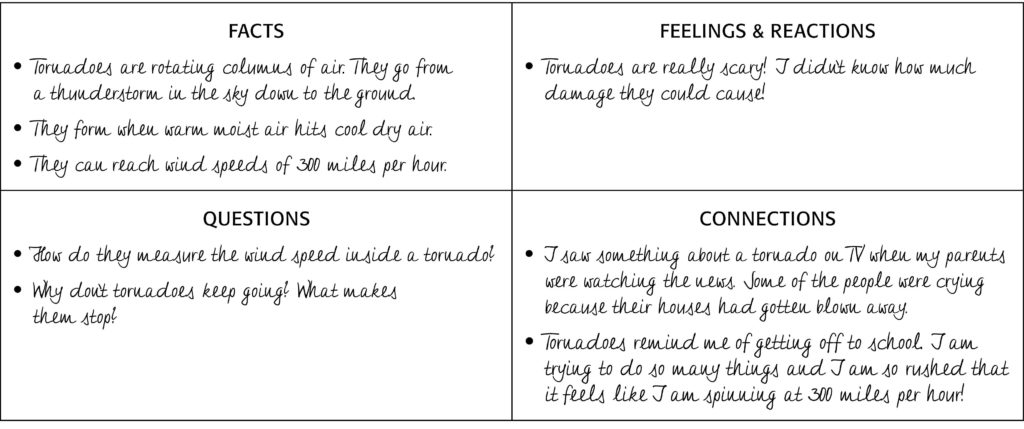Guest blog post from Matthew Perini, co-author of Tools for Classroom Instruction That Works (2018)
Imagine asking hundreds of students and adults to share their unfiltered thoughts and feelings about taking notes in school. What do you think you’d get back? It turns out that our team has actually conducted this mini research experiment in schools across the country, and here are the most common responses: pained faces, deep shudders, a litany of adjectives like boring, tedious, and torture (not technically an adjective, but you get the idea.)
Are these responses about what you expected? Are they similar to what your own would be if you were one of the respondents?
This visceral and negative response to notes is a real problem because we know from research (and experience) just how important notes are to student success. In fact, the comprehensive meta-analytic study that underpins the second edition of Classroom Instruction That Works (2012) shows that teaching students how to make effective notes is one of the highest-yield strategies of all, with associated student gains of over 30 percentile points (Beesley & Apthorp, 2010).
So what can we do to change students’ perceptions of notes? How do we flip the script so that our students see notes not as an unpleasant chore they’ve been forced to complete but as the powerful form of learning that we know notes can be? The answer comes down to one little letter: Instead of training students to take notes, which implies passive copying, we can empower students to make notes, which suggests a creative and personal act of learning.
Window Notes is a tool that helps students create more meaningful, more dynamic, and more personal notes. And like most of the tools in Tools for Classroom Instruction That Works, it’s easy to incorporate into the classroom tomorrow. It’s really as simple as making two lines on a sheet of paper to divide the note-making space into four separate quadrants that resemble a window. Each quadrant gives students a different way to interact with content and create their notes. Students use the quadrants to record important facts and details, ask questions that interest them, make connections to past learning and to their own lives, and express their personal feelings and reactions to what they’re learning.
Below, for example, is a set of Window Notes that a 4th-grade student made while learning about tornadoes. Notice, in addition to the important facts the student collected, the curiosity in the QUESTIONS quadrant, the personalization of the learning in the CONNECTIONS quadrant, and the emotional response in the FEELINGS & REACTIONS quadrant.

Source: From Tools for Classroom Instruction That Works: Ready-to-Use Techniques for Increasing Student Achievement (p. 161), by H. F. Silver, C. Abla, A. L. Boutz, and M. J. Perini, 2018, Franklin Lakes, NJ: Silver Strong & Associates and McREL International. © 2018 Silver Strong & Associates. Used with permission.
If you’re at all worried that the Window Notes tool might seem a little “fluffy” for your classroom, here are two reasons to stop worrying and start using Window Notes immediately:
- Window Notes greatly increases the active processing of content. What so often happens in classrooms that promote note copying is that students’ minds go dormant. But as education experts Jay McTighe and Harvey Silver (ASCD 2020) argue, meaning doesn’t get made unless teachers actively engage students in making that meaning for themselves. With Window Notes, you are giving your students more ways—and more engaging ways—to process and make meaning of what they’re learning. Take a look at the free copy of the Window Notes tool [free tool download], and you’ll see that it is an ideal way for teachers of all content areas and at all grade levels to help students build deeper understanding of important content.
- Window Notes is not meant to replace all forms of note making. This is not an argument to banish webbing, Cornell Notes, graphic organizers, or other types of notes from your classroom forever. Students need to learn multiple ways of making notes, which is one reason why the tools-based approach to improving note making presented in Tools for Classroom Instruction That Works is so useful: It gives teachers and students a variety of tools for making notes that achieve different learning purposes. Of these tools, Window Notes is one of the most important. Why? Because if our classrooms continue to produce legions of note-haters. If we turn students off to notes early in their academic careers, then it will be far more difficult to help students fill their note-making toolboxes as they progress through the grade levels. With Window Notes, we have a way to encourage students to become true note-creators, rather than lifelong note-haters.



One Comment